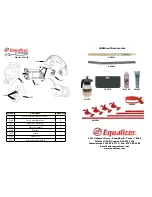
Keep the sheath clean inside!
Failure to do so can put excess strain on the drive unit and damage it.
We will not warranty tools damaged in this way!
Remember to always remove sheath
prior to changing the blade.
Sheath Maintenance
If urethane or butyl is pulled up into the sheath it can be cleaned by removing
the sheath and soaking it in a solvent. Avoid the use of harsh cleaners such as
lacquer thinner or similar “hot” cleaners. We recommend soaking the sheath in an
upright position so the urethane or butyl will drain out the bottom of the sheath.
Changing The Sheath
Pull back on the sheath release lever and slide
sheath in or pull sheath out. Can also be adjusted
to desired length with the notches on the sheath.
There are eight notches measuring 1/8” apart.
General Safety Information
1. Always wear safety glasses and safety gloves when using Equalizer
®
tools.
2. Do not activate Equalizer
®
tools until they are in the cutting position. Disengage
the tool and let it stop before taking it out of the urethane.
3. The blade is sharp and can cut even when the tool is not running.
4. Do not force the tool. Put light forward pressure on the tool.
Let it do the work.
5. Consider your work environment. Do not use or expose power tools in rain
or damp weather.
6. Unplug electric tools before servicing and when
changing accessories.
7. Stay Alert!! Watch what you are doing. Use common sense.
Remove & Replace
Windshields, Side Glasses & Back Glasses
Remove and replace windshields without breaking
them. Because of the thin blade (it is actually .002”
thinner than a normal piece of cut-out wire) you can
use your Equalizer
®
LiveWire
™
to remove auto glass
without breaking it. Keep the blade moving and use
Equalizer
®
Cutting Lubricant. Use a utility knife to
cut down to the pinchweld, on the outside, taking
care not to let the knife cut into the paint. Use your
Equalizer
®
LiveWire
™
to cut the glass loose from the
urethane. On encapsulated or underside mouldings,
turn the blade over so the flat side is against the pinchweld. If the blade is not turned
over it can cut into the plastic or moulding and damage them.
Plunge Cuts & Cutting
Start the tool with the blade a short distance from the urethane. Then, with the tool
running at full speed, push the blade into the urethane. This is called a plunge cut.
Grip the tool firmly and do not allow it to kick back. Plunge cutting works better
with the tool running at full speed. Plunge cutting is possible because the blade is
sharp around the end. After the plunge cut you can cut in either direction because
the blade is sharp on both sides.
Proper Tool Use
The sheath is curved so the drive unit can be
held away from the glass. This curvature keeps
the blade from bending as it comes out of the
sheath. Not holding the tool so the blade goes
straight in and out can cause excessive friction,
overheating the blade and causing it to break.
Right
Dash
Glass
Glass
Dash
Wrong





